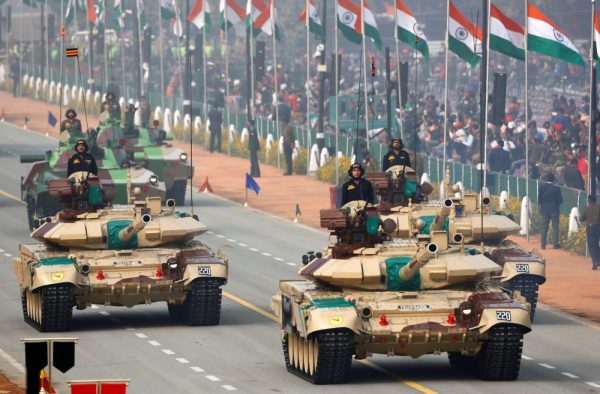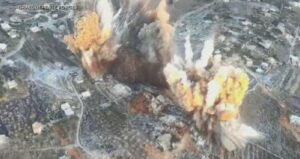The following article first appeared in Warrior Maven, a Military Content Group member site.
The last two weeks have been a landmark for India’s military, which is undergoing a rapid modernization as it tries to counter a growing threat from China.
India’s second nuclear missile submarine was launched, the air force announced plans to speed up the acquisition of 26 French warplanes to be deployed on the country’s latest aircraft carrier and the government okayed the purchase of seven stealth frigates and almost 1,700 main battle tanks.
The naval component of these acquisitions are crucial. There’s concern over control of the Indian Ocean, which India use for 80 per cent of its oil imports and 95 percent of its trade.
The submarine, INS Arighat, is going into service roughly seven years after it was launched at the Indian Navy’s Ship Building Center in Visakhapatnam. Arighat was built with Russian steel and is powered by a pressurized light water reactor developed with Russian assistance. According to Janes, the sub is armed with 12 K-15 Sagarika ballistic missiles, a two-stage solid-propellant weapon with a range of more than 430 miles.
India is expected to build as many as six nuclear-powered submarines. Three of them will eventually fire the K-4 submarine-launched ballistic missiles, which have a range of more than 2,100 miles. If fired from the Indian Ocean, those missiles could hit targets in China.
That could prove critical to deterring China in the Indo-Pacific. The Pentagon is counting on that at a time when the US Navy has yet to deploy its Columbia-class submarines, which will replace the Ohio-class ballistic subs. The first one isn’t expected to go into service until 2031.
The following article first appeared in Warrior Maven, a Military Content Group member site.
The last two weeks have been a landmark for India’s military, which is undergoing a rapid modernization as it tries to counter a growing threat from China.
India’s second nuclear missile submarine was launched, the air force announced plans to speed up the acquisition of 26 French warplanes to be deployed on the country’s latest aircraft carrier and the government okayed the purchase of seven stealth frigates and almost 1,700 main battle tanks.
The naval component of these acquisitions are crucial. There’s concern over control of the Indian Ocean, which India use for 80 per cent of its oil imports and 95 percent of its trade.
The submarine, INS Arighat, is going into service roughly seven years after it was launched at the Indian Navy’s Ship Building Center in Visakhapatnam. Arighat was built with Russian steel and is powered by a pressurized light water reactor developed with Russian assistance. According to Janes, the sub is armed with 12 K-15 Sagarika ballistic missiles, a two-stage solid-propellant weapon with a range of more than 430 miles.
India is expected to build as many as six nuclear-powered submarines. Three of them will eventually fire the K-4 submarine-launched ballistic missiles, which have a range of more than 2,100 miles. If fired from the Indian Ocean, those missiles could hit targets in China.
That could prove critical to deterring China in the Indo-Pacific. The Pentagon is counting on that at a time when the US Navy has yet to deploy its Columbia-class submarines, which will replace the Ohio-class ballistic subs. The first one isn’t expected to go into service until 2031.
India maintains a no-first-strike policy when it comes to nuclear weapons. Still, one naval expert told India Defense News that it’s critical that India has the ability to respond to an attack.
“India must have what is called a second-strike capability, a submarine with nuclear propulsion which also carries ballistic nuclear-tipped missiles are the ultimate guarantors of a nation’s survival,” said retired naval officer Uday Bhaskar, who is now with the Society for Policy Studies in New Delhi.
Meanwhile, India will import 26 French-made Rafale maritime fighters faster than expected after dropping plans to equip them with Indian-built radar systems. The planes will eventually be deployed on the 40,000-ton aircraft carrier INS Vikrant.
The Indian Navy chose the Rafale after a series of tests, giving it the nod over the Boeing F/A-18 Super Hornet. India already flies the Air Force variant of the Rafale. The plane’s manufacturer, Dassault, says it “meets the requirement to perform the widest range of missions with the smallest number of aircraft.”
US-made jets aren’t out of the running when it comes to the Indian Air Force. Former Air Marshal Anil Chopra is urging that while India is developing its own Advanced Medium Combat Aircraft (AMCA), it should acquire two to three squadrons of advanced fighters such as Lockheed Martin’s F-35. The AMCA isn’t likely to be operational until 2035, and India could use the F-35 to counter China’s J-20 fighters.



